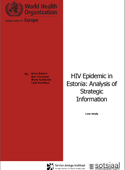HIV epidemic in Estonia: analysis of strategic information. Case study (2011)

Download
By Kristi Rüütel, Aire Trummal, Maris Salekešin, Cyril Pervilhac
2011, viii + 115 pages
ISBN 978 92 890 0257 8
This publication is only available online.
This publication describes an in-depth retrospective secondary data analysis, using triangulation principles, that was conducted to analyse the course of the HIV/AIDS epidemic in Estonia, describe the interventions implemented and provide guidance and input for priority setting. The researchers also highlighted main data gaps and made recommendations to improve surveillance and interventions. The exercise showed that: HIV transmission is slowly but steadily decreasing in Estonia, injecting drug use remains the most important transmission route and the HIV epidemic continues to affect vulnerable populations more, particularly injecting drug users (IDUs) and their sexual partners.
Many HIV/AIDS interventions were significantly scaled up in Estonia over the last decade, and the decline in newly diagnosed HIV cases among young people indicates that prevention efforts are affecting this group’s behaviour and are having a positive impact on the epidemic. Further scale-up and quality improvement of harm-reduction services are important to prevent infection in IDUs. The authors recommend scaling up HIV testing in all settings, improving post-test counselling, developing more active partner counselling and contact-tracing services, more active referral systems to infectious disease services, support for adherence to treatment and intervention monitoring. As behaviour-change interventions for people living with HIV are very limited in Estonia, counselling on sexual behaviour and drug use and access to services for sexual health and sexually transmitted infections should be improved.



